Hydro vs. Air Excavation

Hydro vs. Air Excavation
Hydro excavating and air excavation may seem like similar processes, so much so that it can be hard to understand the differences aside from the obvious one that is one process uses water and one uses air. While these digging alternatives are very similar in application and cost, there are key differences that make one better for certain projects over the other. If you are considering either hydro or air excavation for your next project and are unsure of which to choose, here is a breakdown of both methods.
Hydro Excavation
Hydro excavation, or hydrovac, uses pressurized water to blast compacted soil and debris and a vacuum to lift it away. Each hydrovac truck usually consists of a water pump, vacuum system, and a tank for excavated waste. Compared to traditional excavation methods, the hydrovac process requires only one truck rather than several backhoes and dump trucks.
Cost
Compared to traditional methods, hydrovac excavation is more cost effective. The entire process requires less equipment, less manpower, and reduces the risk of potential utility line repair, collectively reducing the cost. Compared to air excavation, however, the cost is very similar.
Safety
With the heavy machinery of other digging methods, hydrovac excavation is significantly safer in terms of work site safety. Because the process also uses water to move soil, it’s also better to use it on sites with underground infrastructure and utility pipelines as the water won’t cause damage. It’s also a safer option for the environment.
Uses
Hydrovac excavation has seemingly endless applications and can be used on virtually any type of ground. From loose soil, to clay, to frozen, hydrovac is the most versatile alternative to traditional excavation.
Air Excavation
Air excavation, also known as dry suction, is essentially the same process as hydrovac sans the pressurized water. Instead, air excavation uses compressed air to blast and move soil. The added benefit to air excavation is that because the dirt that is excavated remains dry throughout the entire process, it can be used later in backfilling.
Cost
Compared to hydrovac, air excavation is very similar in cost. However, air excavation is a much slower process meaning the equipment and crews are needed for longer, potentially increasing the overall cost of a project. Compared to traditional excavation, however, it is the cheaper option.
Safety
Both hydrovac and air are the significantly safer options when it comes to excavation processes. There isn’t much difference between each respective method, however, compared to traditional excavation, they are both much safer for crews, infrastructure, and the environment.
Uses
Application is where air excavation falls short compared to hydrovac. While it is usually the preferred method on projects close to public roads and highways because it reduces the risk of traffic hazards, air excavation doesn’t have the versatility that hydrovac does. Clay and frozen ground are hard to excavate with only compressed air, so in these cases, hydrovac is the better option.
